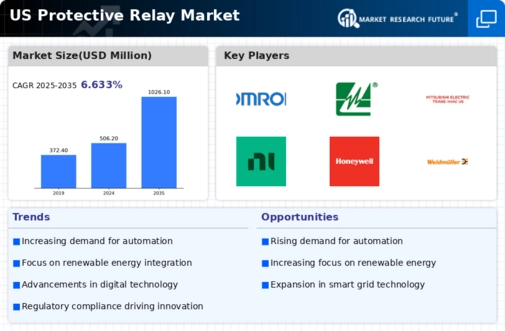Regulatory and Compliance Pressures
The protective relay market is significantly impacted by regulatory and compliance pressures within the energy sector. Stricter safety standards and regulations are being implemented to ensure the reliability and security of electrical systems. The Federal Energy Regulatory Commission (FERC) has established guidelines that mandate the use of advanced protective relays to enhance grid reliability. Compliance with these regulations is essential for utilities to avoid penalties and ensure operational continuity. As a result, the protective relay market is expected to grow as companies invest in compliant technologies. The market is projected to reach a valuation of $1.2 billion by 2030, driven by the need for adherence to evolving regulatory frameworks. This trend highlights the critical importance of protective relays in maintaining compliance and ensuring the safety of electrical infrastructure.
Increased Focus on Energy Efficiency
The protective relay market is benefiting from an increased focus on energy efficiency within the energy sector. As organizations strive to reduce operational costs and minimize energy waste, the demand for protective relays that optimize energy consumption is on the rise. Energy-efficient protective relays contribute to lower energy losses and improved system performance, aligning with the broader goals of sustainability. According to the U.S. Energy Information Administration, energy efficiency measures could reduce electricity consumption by up to 20% by 2030. This shift towards energy efficiency is likely to drive investments in advanced protective relay technologies, further propelling market growth. The protective relay market is thus positioned to play a pivotal role in achieving energy efficiency targets across various industries.
Rising Demand for Grid Modernization
The protective relay market is influenced by the rising demand for grid modernization across the United States. Aging infrastructure and the need for enhanced reliability are prompting utilities to invest in advanced protective relay systems. The U.S. Department of Energy has indicated that approximately 70% of the nation's transmission lines are over 25 years old, necessitating upgrades to ensure safety and efficiency. This modernization effort includes the deployment of smart grid technologies, which rely heavily on sophisticated protective relays to manage and protect electrical networks. As a result, the protective relay market is expected to witness substantial growth, with an estimated increase in market value reaching $1.5 billion by 2030. This trend underscores the critical role of protective relays in maintaining grid stability and reliability.
Growing Adoption of Renewable Energy Sources
The protective relay market is experiencing growth due to the increasing adoption of renewable energy sources in the United States. As the energy landscape shifts towards solar, wind, and other renewable technologies, the need for reliable protective relays becomes paramount. These systems are essential for managing the complexities associated with integrating renewable energy into existing grids. The U.S. Department of Energy reports that renewable energy sources accounted for approximately 20% of total electricity generation in 2025, a figure that is expected to rise. This transition necessitates advanced protective relay solutions to ensure the stability and reliability of power systems. Consequently, the protective relay market is likely to expand as utilities and energy producers invest in technologies that support renewable energy integration.
Technological Advancements in Protection Systems
The protective relay market is experiencing a surge due to rapid technological advancements in protection systems. Innovations such as digital relays and microprocessor-based devices enhance the reliability and accuracy of fault detection. These advancements allow for real-time monitoring and data analysis, which are crucial for preventing electrical failures. The market is projected to grow at a CAGR of approximately 6.5% from 2025 to 2030, driven by the increasing demand for efficient and reliable protection solutions. Furthermore, the integration of artificial intelligence and machine learning into protective relays is expected to improve decision-making processes, thereby enhancing system performance. As utilities and industries seek to modernize their infrastructure, the protective relay market is likely to benefit significantly from these technological improvements.
























Leave a Comment